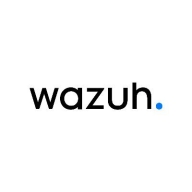

Securonix Next-Gen SIEM and Wazuh compete in the security information and event management category. Securonix appears to have the upper hand due to its advanced threat detection and cloud-native integration.
Features: Securonix Next-Gen SIEM offers advanced behavioral analytics, threat chaining, and customizable analytics that enhance monitoring and threat detection, especially in cloud environments. It also provides flexibility with packaged use cases and API-based connectors, vital for cloud-first companies. Wazuh excels in its open-source nature, offering cost-effective solutions and features like file monitoring, threat hunting, and easy integration.
Room for Improvement: Securonix could simplify its complex feature set and improve integration with platforms like ServiceNow. Deployment and parsing complexities need streamlining. Wazuh could enhance AI integration and reporting mechanisms, and requires better interoperability with enterprise solutions, focusing on cloud and AI enhancements.
Ease of Deployment and Customer Service: Securonix supports varied deployment models, including on-premises and multiple cloud environments, with strong customer support and proactive services. Wazuh primarily offers on-premises and some hybrid deployments. It relies on community support due to its open-source model, lacking dedicated support services.
Pricing and ROI: Securonix uses a pricing model based on identities and events per second, which can appear complex and costly, though ROI is measurable through incident reduction. Wazuh's open-source model minimizes acquisition costs but can raise indirect costs due to self-support needs. Securonix offers advanced features, while Wazuh provides affordability and flexibility at the potential cost of additional management overhead.
The solution is time-saving, particularly in the long run after it is deployed, enabling us to get value promptly.
I have seen value in security cost savings with Wazuh, as using proprietary EDR versions could save us substantial money.
There is no UK-based support, which leads to delays in waiting for US support.
If I raise a ticket, it initially goes to the L1 team, but the next level of escalation is really effective.
They excel in response times and quick reactions when there's an actual threat.
They responded quickly, which was crucial as I was on a time constraint.
We use the open-source version of Wazuh, which does not provide paid support.
The documentation is good and provides clear instructions, though it's targeted at those with technical backgrounds.
I can rate it around eight to nine, and it is very scalable and capable of handling tasks, especially for the on-premises product.
We have not had any customers come back to say they cannot scale at the speed of their business growth.
The solution is scalable as it is cloud-based and cloud-native.
It can accommodate thousands of endpoints on one instance, and multiple instances can run for different clients.
Currently, I don't see any limitations in terms of scalability as Wazuh can still connect many endpoints.
Scalability depends on the configuration and the infrastructure resources like compute and memory we allocate.
The stability of Securonix Next-Gen SIEM is based on the events we are processing.
The stability of Wazuh is strong, with no issues stemming from the solution itself.
The stability of Wazuh is largely dependent on maintenance.
The indexer frequently times out, requiring system restarts.
At the admin level, we have many challenges where log parsing is causing issues and compatibility is not present.
The passing and setup are quite complex at the beginning, making onboarding not smooth.
SIEM could have better integration with other technologies.
The integration modules are insufficiently developed, necessitating the creation of custom integration solutions using tools like Logstash and PubSub.
I think Wazuh should improve by introducing AI functionalities, as it would be beneficial to see AI incorporated in the threat hunting and detection functionalities.
Wazuh could improve by creating videos on YouTube covering installation, use cases, and integration of third-party APIs for different scenarios that other SAAS services provide.
Licensing is based on events per second (EPS), costing between $50 to $60 per EPS.
The solution is definitely not expensive.
The pricing has similar ingestion charges compared to other solutions, such as Splunk.
Wazuh is completely free of charge.
Totaling around two lakh Indian rupees per month.
Wazuh is free to use, but there are licensing fees for third parties.
The software includes user behavior interactions, dashboards, and training capabilities.
Now, the process is automatic, reducing our workload.
The other SIEM solutions lack an option for big data analysis, whereas in the Securonix Next-Gen SIEM, we have this option.
Wazuh is a SIEM tool that is highly customizable and versatile.
The system allows us to monitor endpoints effectively and collect security data that can be utilized across other platforms such as SOAR.
With this open source tool, organizations can establish their own customized setup.
| Product | Market Share (%) |
|---|---|
| Wazuh | 10.9% |
| Securonix Next-Gen SIEM | 1.1% |
| Other | 88.0% |


| Company Size | Count |
|---|---|
| Small Business | 10 |
| Midsize Enterprise | 5 |
| Large Enterprise | 19 |
| Company Size | Count |
|---|---|
| Small Business | 25 |
| Midsize Enterprise | 15 |
| Large Enterprise | 8 |
Securonix Next-Gen SIEM is a security information and event management solution designed to provide advanced threat detection, response, and compliance capabilities. It leverages machine learning and big data analytics to offer a comprehensive security platform for modern enterprises.
Securonix Next-Gen SIEM utilizes advanced analytics and machine learning to detect complex threats that traditional SIEM solutions might miss. Its architecture is built on Hadoop, enabling scalability and the processing of large volumes of data in real-time. This allows organizations to gain deep insights into security incidents, prioritize threats, and automate response actions. The solution also includes behavior analytics to detect insider threats and unknown attacks, integrating seamlessly with existing IT infrastructure.
What are the critical features of Securonix Next-Gen SIEM?
What is the ROI expectations?
Securonix Next-Gen SIEM is implemented across various industries, including finance, healthcare, and retail. Its flexibility and advanced analytics capabilities make it suitable for environments with complex security needs. In finance, it helps detect fraud, while in healthcare, it ensures patient data security. In retail, it protects against data breaches and payment fraud.
In summary, Securonix Next-Gen SIEM offers advanced threat detection, scalability, and integration capabilities, making it a robust solution for modern enterprises.
Wazuh offers comprehensive security features like MITRE ATT&CK correlation, log monitoring, and cloud-native infrastructure. It ensures compliance and provides intrusion detection with high scalability and open-source flexibility, ideal for businesses seeking robust SIEM capabilities.
Wazuh stands out in security information and event management by providing efficient log aggregation, vulnerability scanning, and event correlation against MITRE ATT&CK. Its capability to integrate seamlessly with environments, manage compliance, and monitor files makes it suitable for cloud-native infrastructures and financial sectors. Despite its technical support needing enhancement and opportunities for improving AI integration and threat intelligence, its open-source nature and cost-effectiveness make it appealing. Users can leverage custom dashboards powered by Elasticsearch for precise data analysis, even though there is a desire for a more user-friendly interface and better enterprise solution integration. Deployment may be complex, but its features contribute significantly to fortified security postures.
What are the essential features of Wazuh?Industries like finance and cloud infrastructure heavily utilize Wazuh for its security strengths. By monitoring endpoints and ensuring compliance with frameworks, companies can improve security posture and swiftly detect anomalies. The platform's focus on event correlation and alerts for security incidents is particularly beneficial.
We monitor all Security Information and Event Management (SIEM) reviews to prevent fraudulent reviews and keep review quality high. We do not post reviews by company employees or direct competitors. We validate each review for authenticity via cross-reference with LinkedIn, and personal follow-up with the reviewer when necessary.